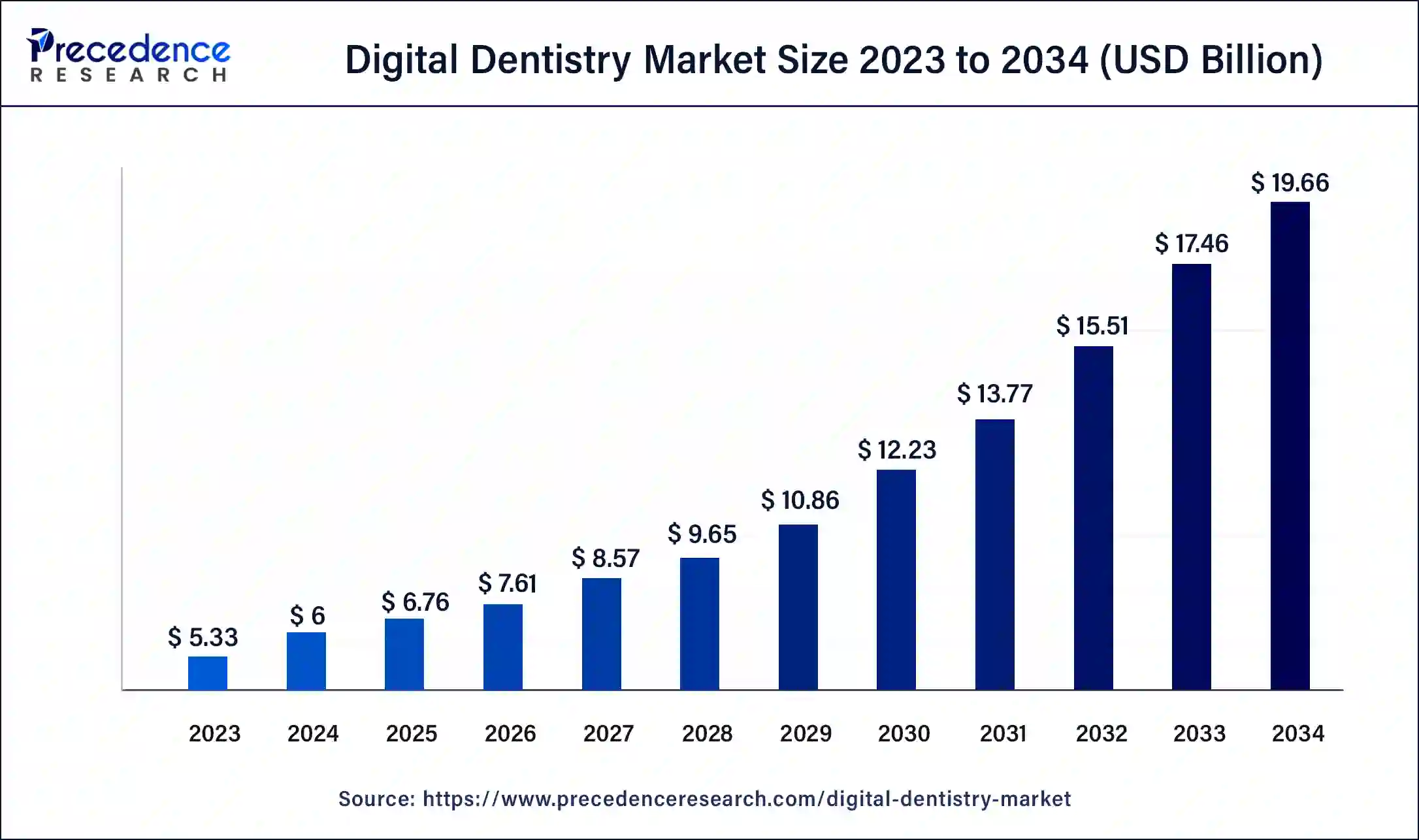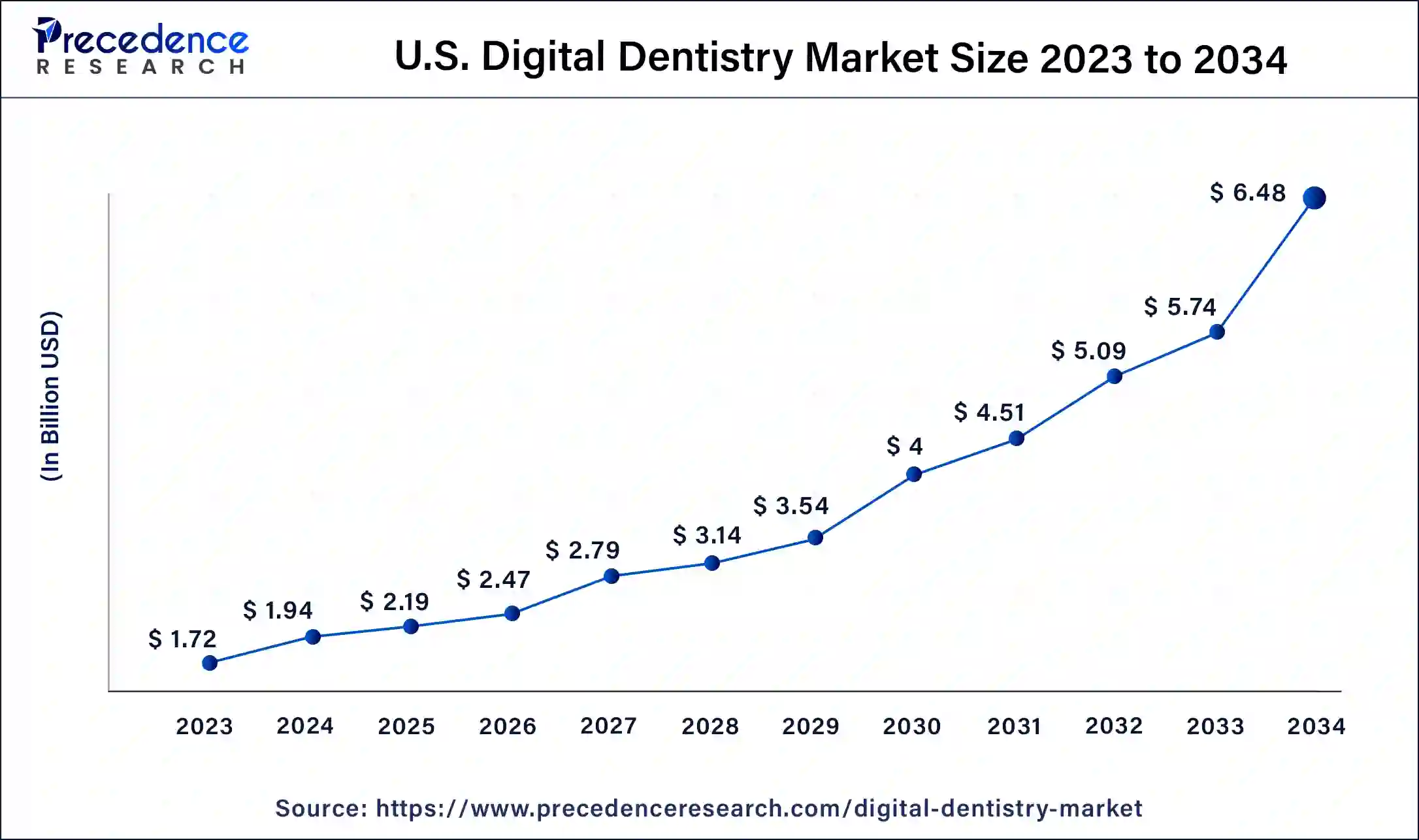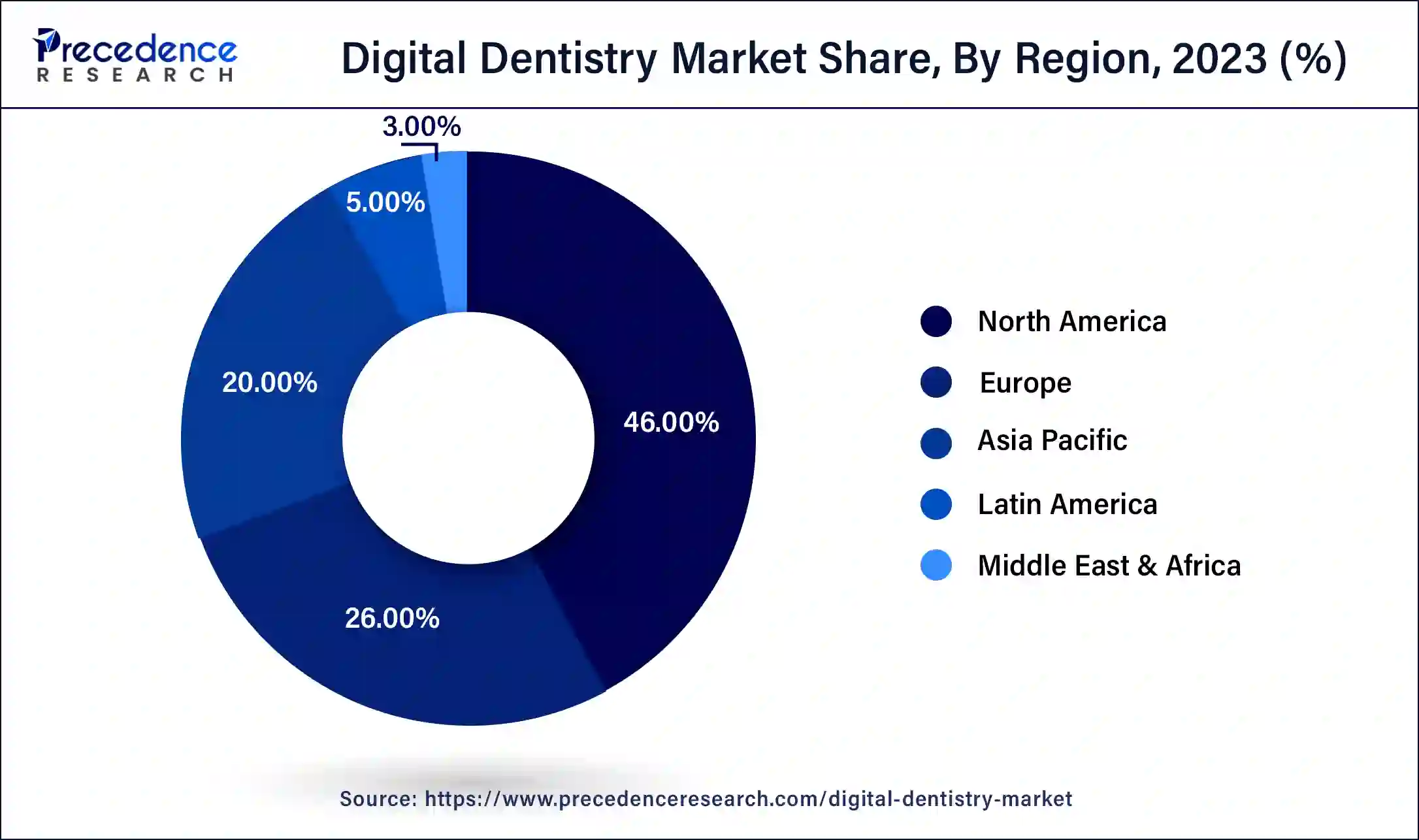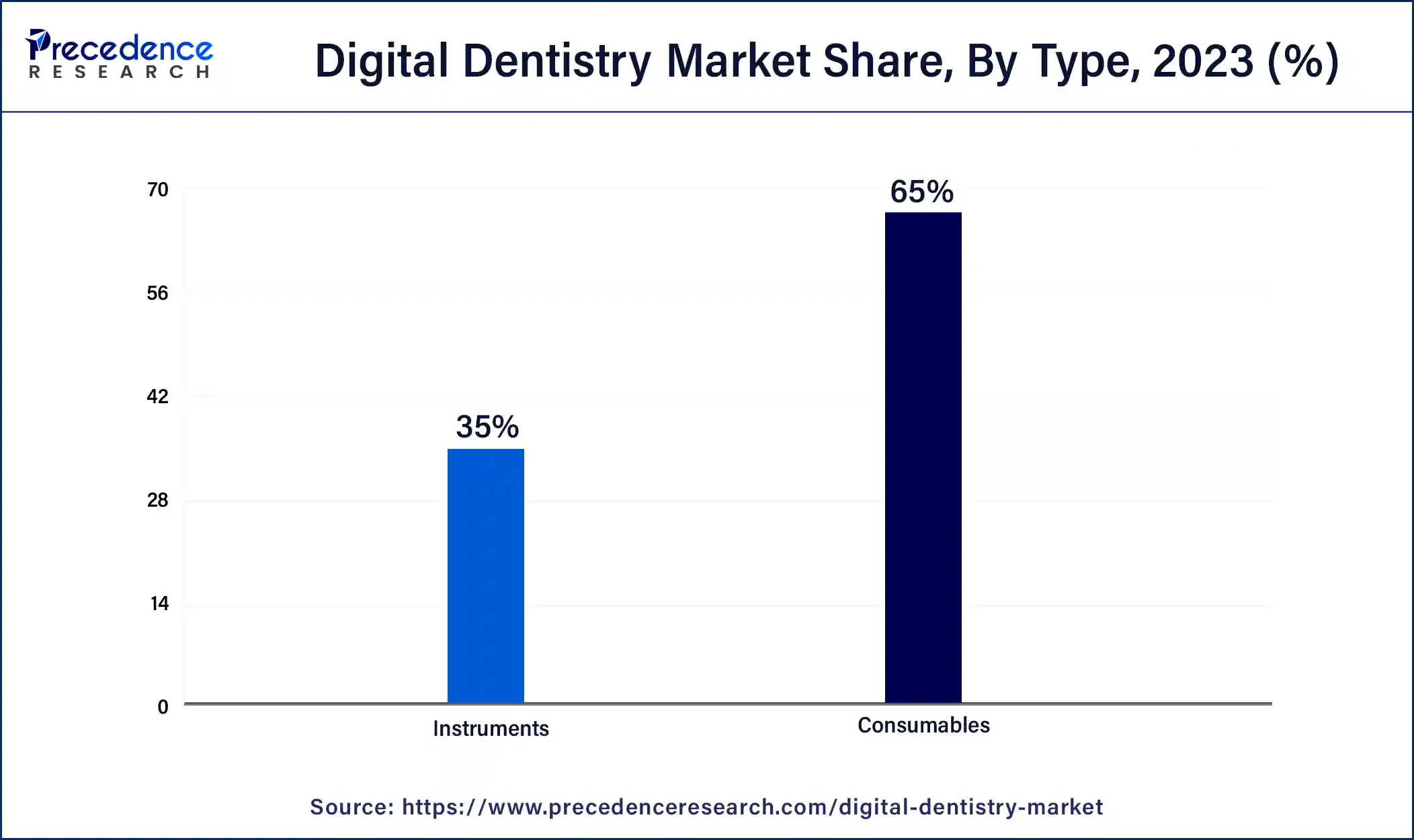Digital Dentistry Market Size and Forecast 2025 to 2034
The global digital dentistry market size accounted at USD 6 billion in 2024 and is expected to be worth around USD 19.66 billion by 2034, at a CAGR of 12.60% from 2025 to 2034.

Digital Dentistry Market Key Takeaways
- The global digital dentistry market was valued at USD 6 billion in 2024.
- It is projected to reach USD 19.66 billion by 2034.
- The digital dentistry market is expected to grow at a CAGR of 12.60% from 2025 to 2034.
- North America contributed more than 46% of revenue share in 2024.
- Asia-Pacific is estimated to expand the fastest CAGR between 2025 and 2034.
- By type, the consumables segment has held the largest market share of 65% in 2024.
- By type, the instruments segment is anticipated to grow at a remarkable CAGR of 14.5% between 2025 and 2034.
- By end user, the hospitals segment generated over 45% of revenue share in 2024.
- By end user, the dental clinics segment is expected to expand at the fastest CAGR over the projected period.
U.S. Digital Dentistry Market Size and Growth 2025 to 2034
The U.S. digital dentistry market size was estimated at USD 1.94 billion in 2024 and is predicted to be worth around USD 6.48 billion by 2034, at a CAGR of 12.82% from 2025 to 2034.

North America has held the largest revenue share 46% in 2024. North America dominates the digital dentistry market due to its robust healthcare infrastructure, high adoption of advanced technologies, and well-established dental care system. The region's significant share is attributed to increased awareness among both practitioners and patients, substantial investments in research and development, and a higher acceptance of innovative dental solutions. Moreover, favorable reimbursement policies, a strong regulatory framework, and the presence of key market players contribute to North America's leading position in driving the growth of the digital dentistry market.

Asia-Pacific is estimated to observe the fastest expansion. Asia-Pacific commands a significant share in the digital dentistry market due to a burgeoning population, rising dental awareness, and increasing healthcare expenditure. The region's rapid economic growth, particularly in countries like China and India, fosters the adoption of advanced dental technologies. Additionally, favorable government initiatives, a growing middle class, and increasing dental tourism contribute to the expanding market. The rising prevalence of dental disorders and the demand for technologically advanced solutions position Asia-Pacific as a key player in driving the growth of the digital dentistry market.
Market Overview
Digital dentistry signifies a modern approach that incorporates cutting-edge technologies into traditional dental processes, boosting accuracy and effectiveness. This comprehensive field includes digital tools like CAD/CAM, intraoral scanners, 3D printing, and advanced imaging systems. Instead of the old-fashioned molds, digital scans create precise 3D models of a patient's mouth. CAD/CAM systems speed up and refine the design of dental restorations, ensuring a perfect fit for items like crowns and bridges. Digital radiography reduces patient exposure to radiation, and intraoral scanners replace the need for uncomfortable traditional impressions.
In essence, digital dentistry streamlines workflows, improves diagnostic accuracy, and elevates overall patient care. This technological evolution marks a significant advancement in dental practices, offering not only enhanced efficiency for dental professionals but also improved comfort and outcomes for patients undergoing various dental procedures.
Digital Dentistry Market Growth Factors
- Technological Advancements: Rapid innovations in digital dentistry, including CAD/CAM systems and 3D printing, drive market growth by enhancing precision and efficiency.
- Increasing Adoption of Intraoral Scanners: The rising preference for intraoral scanners streamlines the impression-taking process, reducing patient discomfort and contributing to market expansion.
- Demand for Improved Diagnostic Capabilities: Digital dentistry's ability to provide detailed and accurate diagnostic information fuels market growth as practitioners seek enhanced insights for treatment planning.
- Growing Awareness of Patient Benefits: The awareness among patients about the advantages of digital dentistry, such as reduced radiation exposure and quicker procedures, contributes to market expansion.
- Shift toward Paperless Dentistry: The move from traditional paperwork to digital records improves workflow efficiency, promoting the adoption of digital dentistry tools and systems.
- Integration of Artificial Intelligence (AI): AI applications in digital dentistry optimize treatment planning, diagnosis, and prosthetic design, fostering market growth.
- Global Increase in Dental Tourism: The rise in dental tourism, coupled with the demand for advanced digital solutions, propels the digital dentistry market on a global scale.
- Expanding Geriatric Population: The aging population's dental care needs drive the demand for digital dentistry solutions that offer tailored and efficient treatment options.
- Government Initiatives and Funding: Supportive government policies and funding initiatives for digital healthcare technologies contribute to the growth of the digital dentistry market.
- Improved Patient Experience: Enhanced patient comfort and reduced treatment times associated with digital dentistry solutions contribute to increased adoption among practitioners.
- Efficiency in Dental Laboratories: Digital dentistry streamlines workflows in dental laboratories, leading to increased productivity and market growth.
- Growing Number of Dental Practices: The increasing number of dental practices incorporating digital technologies augments the overall market size.
- Advancements in Imaging Technologies: Continuous advancements in imaging technologies, such as CBCT and 3D imaging, drive demand for digital dentistry solutions.
- Dental Education Embracing Digital Tools: The integration of digital dentistry tools in dental education programs fosters familiarity and adoption among future practitioners.
- Tele-dentistry Trends: The rise of tele-dentistry models, enabled by digital tools, contributes to market growth by expanding access to dental care.
- Customization of Prosthetics: Digital dentistry allows for highly customized prosthetics, meeting the increasing demand for personalized dental solutions.
- Economic Benefits for Dental Practices: Cost-effectiveness and improved efficiency associated with digital dentistry systems attract dental practices, supporting market growth.
- Collaborations and Partnerships: Increasing collaborations between dental technology companies and healthcare providers drive innovation and market expansion.
- Patient-Centric Care: The shift towards patient-centric care, facilitated by digital dentistry, enhances overall treatment outcomes and drives market growth.
- Environmental Sustainability: The move towards digital workflows reduces the environmental impact of traditional dental practices, contributing to the market's sustainable growth.
Market Scope
| Report Coverage | Details |
| Growth Rate from 2025 to 2034 | CAGR of 12.6% |
| Market Size in 2024 | USD 6 Billion |
| Market Size in 2025 | USD 6.76 Billion |
| Market Size by 2034 | USD 19.66 Billion |
| Largest Market | North America |
| Base Year | 2024 |
| Forecast Period | 2025 to 2034 |
| Segments Covered | By Type and By End User |
| Regions Covered | North America, Europe, Asia-Pacific, Latin America, and Middle East & Africa |
Market Dynamics
Driver
Patient-centric care and enhanced diagnostic capabilities
Patient-centric care and enhanced diagnostic capabilities are pivotal factors surging the demand for digital dentistry. The emphasis on patient comfort and convenience aligns with a contemporary healthcare approach, fostering a preference for streamlined and less invasive dental procedures. Digital dentistry's ability to provide a patient-friendly experience, such as the use of intraoral scanners instead of uncomfortable traditional impressions, resonates positively with individuals seeking more pleasant dental visits. Furthermore, the heightened diagnostic precision offered by digital dentistry tools significantly influences market demand. Advanced imaging technologies, coupled with computer-aided design and manufacturing (CAD/CAM) systems, empower dental practitioners with comprehensive and detailed insights into patients' oral health conditions. This not only aids in accurate diagnosis but also facilitates more personalized treatment plans. As patients increasingly prioritize efficient and precise dental care experiences, the integration of patient-centric care and advanced diagnostics becomes a driving force in shaping the expanding landscape of the digital dentistry market.
Restraint
Resistance to change and data security concerns
Resistance to change and data security concerns act as formidable restraints on the market demand for digital dentistry. Traditionalist sentiments within the dental community can create reluctance among practitioners to shift from conventional methods to digital workflows. This resistance may stem from a comfort with established practices and a hesitation to embrace the learning curve associated with advanced technologies. Overcoming this resistance necessitates targeted education and training programs to familiarize dental professionals with the benefits and ease of use of digital dentistry tools. Simultaneously, data security concerns pose a significant barrier to the widespread adoption of digital dentistry. As patient records and diagnostic data become digitized, the vulnerability of sensitive information to cyber threats becomes a critical issue. Dental practices and patients may hesitate to fully embrace digital solutions without robust assurances of secure data storage and transmission. Establishing stringent data security protocols, compliance with regulatory standards, and fostering awareness about the reliability of digital systems are crucial steps to address these concerns and instill confidence in the adoption of digital dentistry practices.
Opportunity
Rising dental tourism and advancements in artificial intelligence
Rising dental tourism and advancements in artificial intelligence (AI) represent significant opportunities for the digital dentistry market. Dental tourism, driven by cost-effective and high-quality dental procedures, provides a robust market avenue. Digital dentistry's efficiency and precision align with the expectations of dental tourists seeking advanced and streamlined treatments, presenting an opportunity for market expansion in popular dental tourism destinations. The integration of AI in digital dentistry introduces innovative diagnostic and treatment planning capabilities, offering enhanced efficiency and accuracy. AI-driven algorithms can analyze vast datasets, aiding in early disease detection and personalized treatment plans. This not only improves patient outcomes but also positions digital dentistry as a forefront solution in the evolving landscape of AI-driven healthcare. Embracing these opportunities can propel the digital dentistry market forward, catering to a diverse global patient base and driving continued advancements in technology and patient care.
Type Insights
In 2024, the consumables segment had the highest market share of 65% on the basis of the type. In the digital dentistry market, the consumables segment encompasses materials used in various digital dental procedures, including CAD/CAM blocks, dental crowns, bridges, and 3D printing resins. This segment is witnessing a notable trend towards the development of advanced materials with improved aesthetics, durability, and biocompatibility. Innovations in nanotechnology and biomaterials are shaping the consumables market, enhancing the quality and efficiency of digital dentistry procedures, and addressing the demand for patient-specific, high-performance dental solutions.

The instruments segment is anticipated to expand at a significant CAGR of 14.5% during the projected period. In the digital dentistry market, the instruments segment encompasses a range of advanced tools used for diagnostic imaging, intraoral scanning, and precision manufacturing. These instruments include intraoral scanners for creating digital impressions, 3D printers for fabricating dental prosthetics, and imaging devices such as CBCT scanners. A notable trend in this segment involves the continuous enhancement of precision and speed in digital workflows, leading to more efficient and accurate diagnostics and treatment planning. Additionally, the integration of artificial intelligence in digital dentistry instruments is a prominent trend, offering sophisticated data analysis and further optimizing clinical outcomes.
End User Insights
According to the end user, the hospitals segment held 45% revenue share in 2024. In the digital dentistry market, the hospital segment refers to dental departments within healthcare institutions that leverage advanced digital technologies. A growing trend in hospitals involves the integration of digital dentistry tools like intraoral scanners and CAD/CAM systems. This allows hospitals to enhance diagnostic capabilities, streamline treatment workflows, and improve overall patient care. The adoption of digital dentistry in hospitals signifies a commitment to cutting-edge dental practices, contributing to more efficient and precise oral healthcare services within a comprehensive healthcare setting.
The dental clinics segment is anticipated to expand fastest over the projected period. Dental clinics, as end-users in the digital dentistry market, refer to facilities where dental practitioners provide a range of oral healthcare services. The trend in dental clinics involves a rapid adoption of digital technologies, including CAD/CAM systems, intraoral scanners, and 3D printing, to enhance diagnostics, treatment planning, and patient care. This integration streamlines workflows, improves precision in prosthetic design, and elevates overall efficiency, allowing dental clinics to offer advanced and patient-centric services, marking a paradigm shift in traditional dental practices.
Digital Dentistry Market Companies
- Align Technology, Inc.
- Dentsply Sirona
- 3M Company
- Danaher Corporation
- Planmeca Oy
- Carestream Health, Inc.
- Ivoclar Vivadent AG
- Institut Straumann AG
- Zimmer Biomet Holdings, Inc.
- Henry Schein, Inc.
- Patterson Companies, Inc.
- KaVo Dental
- Roland DG Corporation
- 3Shape A/S
- Kuraray Noritake Dental Inc.
Recent Developments
- In November 2022,Imagoworks Inc. introduced the 3Dme Crown, an AI-driven web dental CAD module. This innovative solution is part of the 3Dme suite and is designed to automatically generate crown prosthesis designs tailored to the unique oral environment of each patient.
- Additionally, in October 2022, DEXIS unveiled the DEXIS IS (Intraoral Scanner) portfolio. This comprehensive suite comprises a range of intraoral solutions, providing a complete set of digital dental diagnostic systems that cater to every scanning stage in dental procedures.
Segments Covered in the Report
By Type
- Instruments
- Consumables
By End User
- Hospitals
- Dental Clinics
- Others
By Geography
- North America
- Europe
- Asia-Pacific
- Latin America
- Middle East and Africa
For inquiries regarding discounts, bulk purchases, or customization requests, please contact us at sales@precedenceresearch.com
Frequently Asked Questions
Ask For Sample
No cookie-cutter, only authentic analysis – take the 1st step to become a Precedence Research client
 sales@precedenceresearch.com
sales@precedenceresearch.com
 +1 804-441-9344
+1 804-441-9344